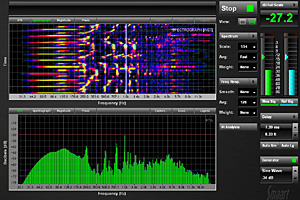
Reply posted by Chip on September 18, 2001
Earl, I’d take some degree of exception to the phrase “phase is time, time is phase”. While this is essentially true, I submit that there can be differences. For example, It’s entirely possible to have two completely time coherant signals. It’s just as possible to adjust the phase of one of those signals, without adjusting it’s time. Agreed?
I’m still trying to completely get my head around this one. But to the best of my understanding, the real trick seems to be realizing the difference. Here’s what I’ve found to be the marker between the two …. phase angle. If the time is correct, the phase angle of the two sources will be parallel. if the phase angle is leaning forward, or backward, it would indicate early or late arrival. In the case where the phase angle is parallel but they don’t overlap, phase adjustment would be the appropriate tool to slide the phase angle without changing the angle. Is this making sense? Any input would be helpful.
Reply posted by Phill Graham on September 18, 2001
Alright Chip, see if this helps. For a wave to be a wave, it has to propagate in both space and time, otherwise it is simply a vibration. Math people wanted to be able describe things that change in a periodic manner. It turns out that trigonometric functions fit the bill nicely. However, you need a conversion factor that takes real world wave position and time, and translates it into the mathematical notion of “angles”.
Hidden in the equations for the wave propagation are two basic parameters. One basically says “swallow up” 30deg. of angle for every foot of travel in the air, and the other says “swallow up” 30 deg. of angle for ever .5sec of time elapsed (or whatever). The combination of these describes the wave’s movent in space and time. “Phase” lumps these two together.
It is important to realize that pure delay is not a flat (zero slope) phase plot, but rather a linear one with a slope proportional to the delay through whatever the device in question is. That is where the term “group delay” (-1st derivative [slope] of the phase) derives from, as the the group delay curve will be completely flat for an device with pure delay.
When Meyer sound talks about their phase correction through the spectrum, it is important to remember the small print at the bottom “phase vs. pure delay.” They are not correcting the phase to represent a flat (zero slope) line, but rather trying to get it to match the straight (but sloped) line of the pure delay between the speaker and the measurement system. Let me know if this makes sense, I wrote it in a hurry.
Reply posted by P.Tucci on September 18, 2001
“I’d take some degree of exception to the phrase “phase is time, time is phase.” Me too. While limiting your discussion to sine waves, I believe that to be true. A 90 degree phase shift of an 1120 hz tone is a quarter mSec of time. A 180 degree phase shift of the same frequency would be half of a wavelength, or half a mSec of time. At other frequencies, the same time displacement does not create a similar degree of phase shift as other have pointed out. It could be argued that phase is time on a specific frequency by frequency basis only.
The longer the wavelength, (lower frequency) the more time is needed to create that degree of phase shift when compared to an equal phase shift of a shorter wavelength (higher frequency. With that in mind, it makes sense that an offset delay introduced at the crossover’s low output will cause a phase shift that affects the upper end of the bandwidth more so than the lower end of the bandwidth. An equal phase shift across that entire bandwidth would have to be differing delay times for differing frequencies. If I got my money’s worth from Jamie, Sam, Don, and Mr. McCarthy, that would be an all pass filter.
Reply posted by Tom Danley on September 18, 2001
“An equal phase shift across that entire bandwidth would have to be differing delay times for differing frequencies. If I got my money’s worth from Jamie, Sam, Don, and Mr. McCarthy, that would be an all pass filter.” This is the behavior of a point source (one who’s diameter is small compared to the wavelength it is producing) with “flat” response. As defined by its electrical equivalent circuit and as measured ala Heyser, a typical woofer, to have flat frequency response, must (mid band) have an acceleration response to the VC force. This is accomplished by the motor force acting on the drivers moving mass which ends up reflecting an RC filter (C being mass). This 1 pole roll off of the radiator velocity counter acts the improving radiation efficiency (an acoustic/dimension related slope with no phase shift associated with because it is a changing resistance), producing flat response but at about a -90 degree acoustic phase shift (input Voltage with respect to output pressure after all fixed time delays are accounted for). At the low end, even in a sealed box or infinite baffle, cabinet tuning will cause a large amount of acoustic phase change, going through zero degrees at resonance (Z max where mass and spring are equal but opposite) to a positive value as the system is dominated by compliance stiffness.
